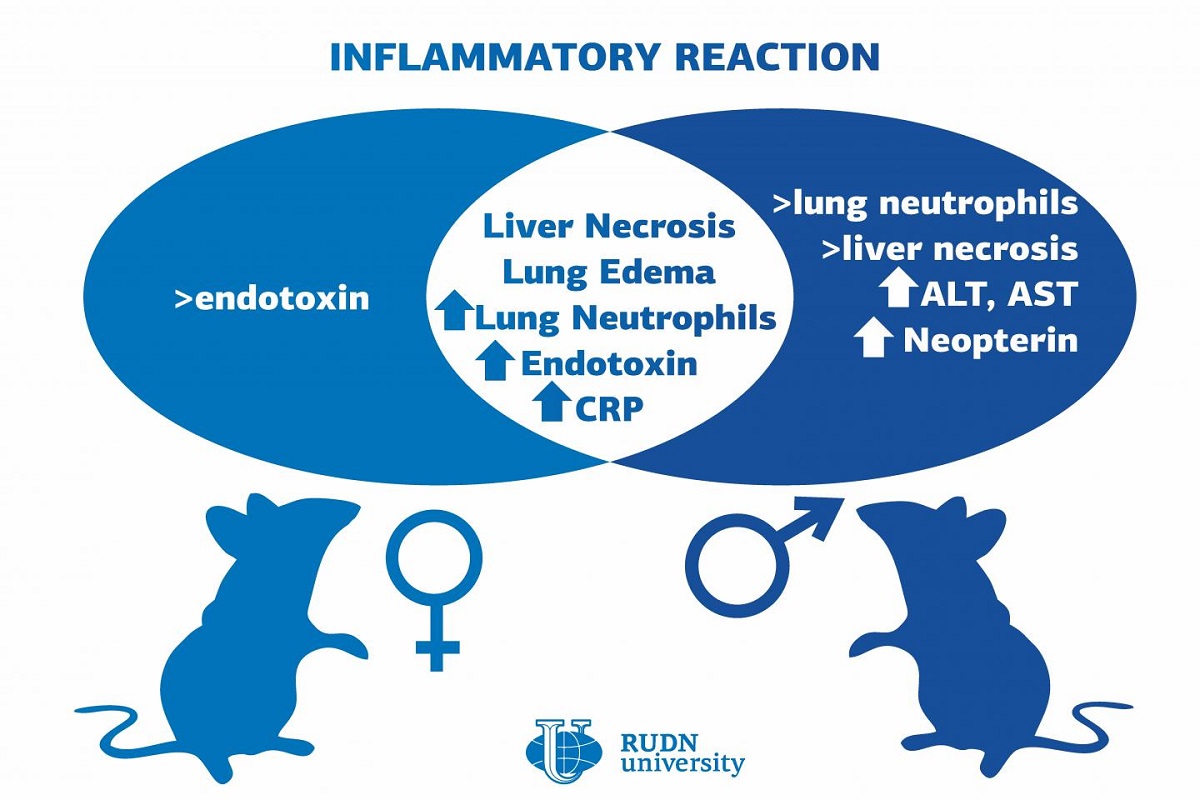RUDN University biologist found sex differences in inflammatory reactions in rat pups

The amount of sex hormones in an animal’s body changes during its life along with the state of its immune system. The correlation between these two processes hasn’t been fully understood yet. It is yet unknown how sex hormones affect the immune systems of animals in the prepubertal period (in humans, this term refers to the age from 6-7 to 11-12 years). A biologist from RUDN University was the first to describe the differences in the immune response in prepubertal male and female rats. The results of the study can help find more effective treatment methods for children’s diseases and increase the safety of vaccines.
“Understanding the peculiarities of the immune response in prepubertal animals can lead to the development of more effective immunotherapeutic approaches and help minimize the side effects of vaccination in children. That is why we decided to focus on the sex differences in the inflammatory response in prepubertal rats,” said Anna Kosyreva, a Ph.D. in Biology, and an Assistant Professor at the Department of Histology, Cytology, and Embryology, RUDN University.
The team used 51 10-day-old rats (21 females and 30 males) in their experiment. 35 of them (12 females and 23 males) were injected with lipopolysaccharide (LPS), a toxic structural component of bacterial cell walls, to imitate septic shock—a common complication of severe infectious diseases. The administered dose (15 mg per one kg of weight) is deadly for adult animals but in the pups, the mortality rate amounted to 17% (2 out of 12) in females and 56% (13 out of 23) for males. 24 hours after the injection the team conducted a histological analysis of the lungs, livers, and thymuses of the survivors as well as the pups from the control group that hadn’t received an injection. Before and after the injection the biologists measured the levels of the sex hormones estradiol and testosterone, as well as corticosteroids (hormones produced only by the adrenal cortex, not the genital glands) in all animals.
According to the team, the sex differences in the immune response to LPS in female and male rats did not depend on sex hormones. However, the progress of the inflammation in males was more severe: the area of liver necrosis in them was seven times larger than in females. Almost all injected pups developed pulmonary edema, but the number of neutrophils (inflammation-targeting cells) in males was 1.5 times higher. This more active inflammatory reaction is likely to be the cause of higher mortality among male rats. This difference could not have been explained by sex hormones. Therefore, the team assumed that the X chromosome could be the case.
The X chromosome contains immune response genes, including the regulators of NF-κB—a factor in charge of the synthesis of inflammation mediators. Females have two X chromosomes, one from each parent. If the genes responsible for NF-κB turn out to be dominant in one of the chromosomes, it takes over the other, and the dominant genes start to determine the production of inflammation mediators. In such a case, an animal has more chances to effectively fight infections. However, the males don’t have this advantage because they only have one X chromosome with a single group of immune response genes.
The results of the study were published in the Scientific Reports journal.
RUDN summarized the results of the scientific competition "Project Start: work of the science club ". Students of the Faculty of Physics, Mathematics and Natural Sciences have created a project for a managed queuing system using a neural network to redistribute resources between 5G segments. How to increase flexibility, make the network fast and inexpensive and reach more users — tell Gebrial Ibram Esam Zekri ("Fundamental Computer Science and Information Technology", Master's degree, II course) and Ksenia Leontieva ("Applied Mathematics and Computer Science", Master's degree, I course).
The National Demographic Report, 2023 Demographic Well-Being of Russian Regions (hereinafter - the National Demographic Report) was prepared by the scientific team of the Institute of Demographic Studies of the Federal Research Center of the Russian Academy of Sciences, the Vologda Scientific Center of the Russian Academy of Sciences, Peoples' Friendship University of Russia, the Center for Family and Demography of the Academy of Sciences of the Republic of Tatarstan, as well as with the participation of leading scientists from the Republic of Bashkortostan, Stavropol Krai, Volgograd, Ivanovo, Kaliningrad, Nizhny Novgorod, Sverdlovsk Oblasts and Khanty-Mansi Autonomous Okrug–Yugra.
RUDN summarized the results of the scientific competition "Project Start: work of the science club ". Students of the Faculty of Physics, Mathematics and Natural Sciences have created a project for a managed queuing system using a neural network to redistribute resources between 5G segments. How to increase flexibility, make the network fast and inexpensive and reach more users — tell Gebrial Ibram Esam Zekri ("Fundamental Computer Science and Information Technology", Master's degree, II course) and Ksenia Leontieva ("Applied Mathematics and Computer Science", Master's degree, I course).
What is your first association with the word “laboratory”? Flasks and beakers? Microscopes and centrifuges? Yes, many of us would answer the same way.
The National Demographic Report, 2023 Demographic Well-Being of Russian Regions (hereinafter - the National Demographic Report) was prepared by the scientific team of the Institute of Demographic Studies of the Federal Research Center of the Russian Academy of Sciences, the Vologda Scientific Center of the Russian Academy of Sciences, Peoples' Friendship University of Russia, the Center for Family and Demography of the Academy of Sciences of the Republic of Tatarstan, as well as with the participation of leading scientists from the Republic of Bashkortostan, Stavropol Krai, Volgograd, Ivanovo, Kaliningrad, Nizhny Novgorod, Sverdlovsk Oblasts and Khanty-Mansi Autonomous Okrug–Yugra.